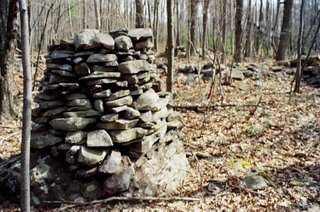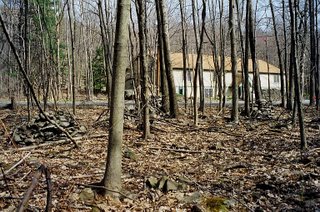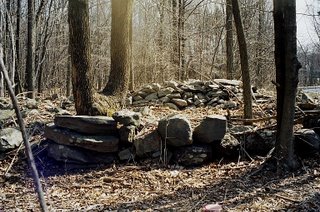Okay. I still have photos to post from a few sites I visited years ago--I have dial-up and uploading takes a long time--, but on Easter I revisited one, the cairn field in Monroe County. As you might expect, some of it has been destroyed. As many as twenty of the rock piles are gone, mostly to make room for a driveway. To the credit of the property owners, though, they let a few stand that they could just have removed, and the ones across the street remain.
The first two pictures below, maybe the first three, are rock piles I have posted before. I took the new pictures to show features that weren't clear before. On the first, you see the back slopes of the mountain that Camelback Ski Area is on on the background. And if you click on and enlarge the picture, you should be able to see the red stones built into this one: one on the bottom right, and a few in a layer about half way up on the left side. Note the stones in front of the pile, too. Yes, this is the same one I showed before with the niche in it.

Same pile, different side. Here you can see the low wall and another rock pile behind it. This pile is not really visible from the road. It's my favorite. I was happy to see it again.

A low but artistic pile nearby. Love the way they're built on the boulders.

Looking toward the road you see more piles, probably collapsed from a more organized form.

This is further down the road from the cairn field. A neat little area, from which a wall continues off to the left. Hints of femininity here, I thought, and not just in the stones, but maybe I'm too imaginative.

As we drove around the area, we saw more walls, more piles, some very large but not as organized. I hope to get back up there in late May to look around more. My son will be home from college, and I'm doing what I can to brainwash him.
We saw a marsh hawk, a.k.a. harrier twice hanging around near that first rock pile, and a red squirrel on the wall near the last picture. There's a huge old oak along the road, too. I'll bet it's close to three hundred years old. Oaks grow slowly, and this was one of the slower growing species. A nice place to visit.
1 comment :
Nice one, to you too. That first one is great and I wonder if the red rock is Hematite.
Just a bit curious: what were the water resources nearby?
Post a Comment